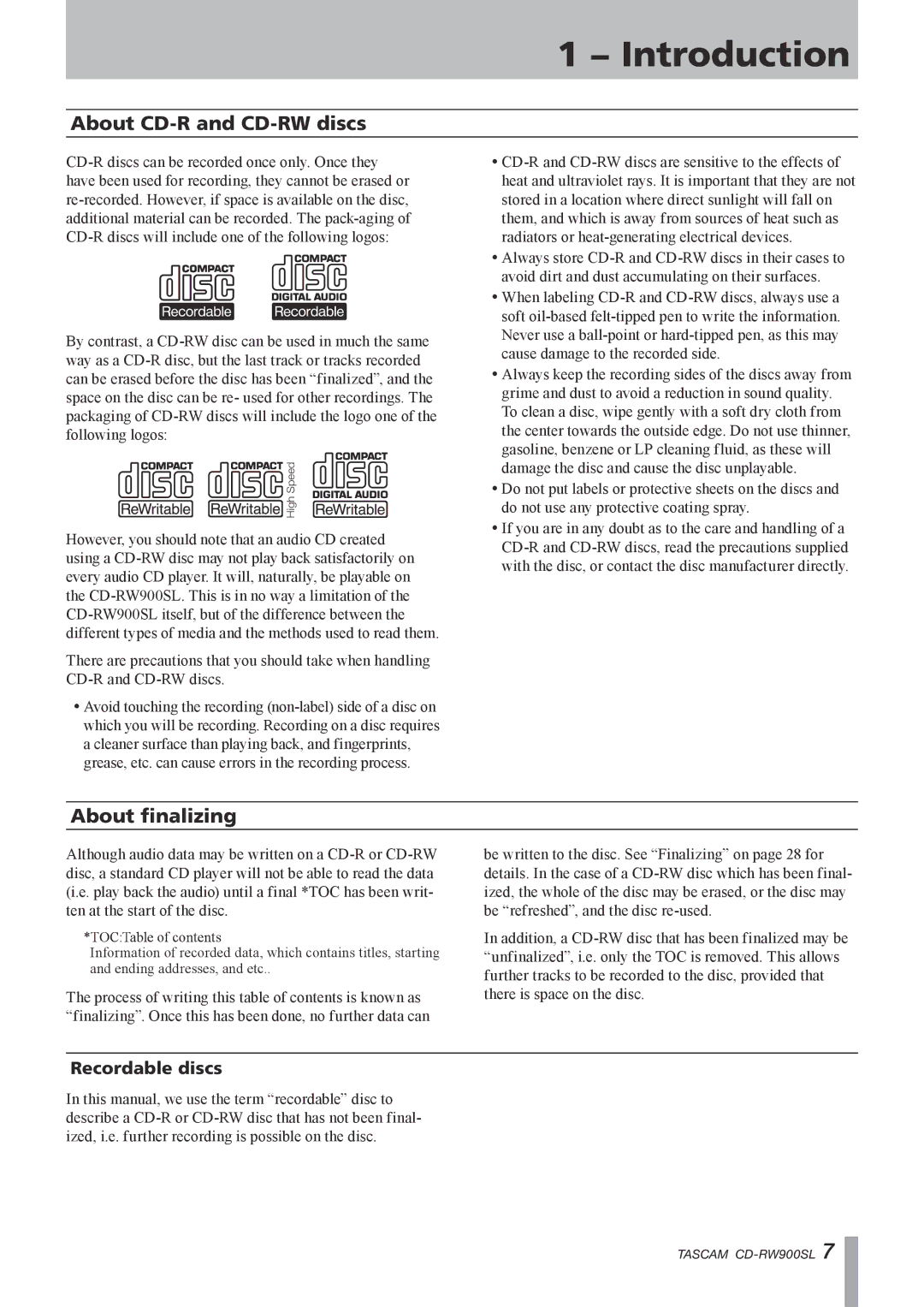About CD-R and CD-RW discs
CD-R discs can be recorded once only. Once they have been used for recording, they cannot be erased or re-recorded. However, if space is available on the disc, additional material can be recorded. The pack-aging of CD-R discs will include one of the following logos:
By contrast, a CD-RW disc can be used in much the same way as a CD-R disc, but the last track or tracks recorded can be erased before the disc has been “finalized”, and the space on the disc can be re- used for other recordings. The packaging of CD-RW discs will include the logo one of the following logos:
 High Speed
High Speed
However, you should note that an audio CD created using a CD-RW disc may not play back satisfactorily on every audio CD player. It will, naturally, be playable on the CD-RW900SL. This is in no way a limitation of the CD-RW900SL itself, but of the difference between the different types of media and the methods used to read them.
There are precautions that you should take when handling CD-R and CD-RW discs.
•Avoid touching the recording (non-label) side of a disc on which you will be recording. Recording on a disc requires a cleaner surface than playing back, and fingerprints, grease, etc. can cause errors in the recording process.
About finalizing
Although audio data may be written on a CD-R or CD-RW disc, a standard CD player will not be able to read the data (i.e. play back the audio) until a final *TOC has been writ- ten at the start of the disc.
*TOC:Table of contents
Information of recorded data, which contains titles, starting and ending addresses, and etc..
The process of writing this table of contents is known as “finalizing”. Once this has been done, no further data can
Recordable discs
In this manual, we use the term “recordable” disc to describe a CD-R or CD-RW disc that has not been final- ized, i.e. further recording is possible on the disc.
•CD-R and CD-RW discs are sensitive to the effects of heat and ultraviolet rays. It is important that they are not stored in a location where direct sunlight will fall on them, and which is away from sources of heat such as radiators or heat-generating electrical devices.
•Always store CD-R and CD-RW discs in their cases to avoid dirt and dust accumulating on their surfaces.
•When labeling CD-R and CD-RW discs, always use a soft oil-based felt-tipped pen to write the information. Never use a ball-point or hard-tipped pen, as this may cause damage to the recorded side.
•Always keep the recording sides of the discs away from grime and dust to avoid a reduction in sound quality. To clean a disc, wipe gently with a soft dry cloth from the center towards the outside edge. Do not use thinner, gasoline, benzene or LP cleaning fluid, as these will damage the disc and cause the disc unplayable.
•Do not put labels or protective sheets on the discs and do not use any protective coating spray.
•If you are in any doubt as to the care and handling of a CD-R and CD-RW discs, read the precautions supplied with the disc, or contact the disc manufacturer directly.
be written to the disc. See “Finalizing” on page 28 for details. In the case of a CD-RW disc which has been final- ized, the whole of the disc may be erased, or the disc may be “refreshed”, and the disc re-used.
In addition, a CD-RW disc that has been finalized may be “unfinalized”, i.e. only the TOC is removed. This allows further tracks to be recorded to the disc, provided that there is space on the disc.

![]() High Speed
High Speed